Ever wanted to bend plywood but don’t have the equipment or the space to use it? Whatever the issue, dust off those project ideas and take a look at [Ryo Kosaka]’s experimental bending jig.All you need are some boards, a couple of fasteners, and [Ryo]’s 3-D printed connectors.
This is quite the elegant solution for bending in a small space with little noise. The main departure from standard bending methods is that instead of making the bend by clamping the veneers between a pair of positive and negative mold halves, most of the clamping pressure comes from air pumped into a rubber ball. That’s not even the best part: not only is the mold reconfigurable, it’s modular. Want another bend in your thing? Just print another connector and grab another piece of wood.
[Ryo]’s pivoting connectors screw into the end of one board and move freely along the length of a second board. Once the bend angle is dialed up, he locks it in place with a bolt. For the first test, [Ryo] made a lamp base with two bends.The jig worked great except for a small gap that didn’t get enough clamping pressure from the ball. We wonder if rotating the jig during the process would have let gravity address the issue. For the second test, [Ryo] added another piece to make the jig rectangular and made a floating wall shelf. Bend your way past the break for the video version.
In making the lamp base, [Ryo] found it easier to pre-bend the veneers with a heat gun. If the project were smaller, he could have softened up the wood in a microwave.
















No idea what you are building? Just call it a lamp!
Stouter brackets and more air pressure. Steam the wood not dry heat, more pliant.
Yeah, I’m certainly no woodworker but even I know that you’re supposed to steam wood to get it to bend. Like for making the curves on a boat hull and such.
That said, I guess the idea here is that you can avoid the steam/equipment. That’s what I got from the “don’t have the equipment or the space to use it” part, anyway.
He succeed to bend the plywood without steam, so what is the problem?
It’s not very repeatable, as the wood tends to splinter when the lignin in the wood isn’t properly soft. There’s a lot of variables like how densely the wood has been growing, how has it been cut, what kind of wood you’re bending, how much you’re bending, what thickness you’re bending…
If it’s soft enough for this case, it’s soft enough, but for other work you may need to steam it.
when you laminate a bunch of thin pieces and glue them together, the tension and compression in the layers themselves keeps the thing in place after the glue dries. If you tried to straighten out the bend, the inside of the bend radius would be too short and would quickly go into tension, the outside of the bend would be too long to straighten and would go into compression.
You typically get ONE shot at steaming the lignin in wood, then it’s pretty much permanently set. Effectively the same if the wood has dried out sufficiently. A few times I’ve steamed for too long, and this seems to set the lignin too, as the wood just snaps instead of bends (even when properly supported while bending).
Steam bending is interesting, even fun. Rigging up a kettle feeding a steaming chamber that’s a vertically sloped drain-back length of ABS tube supported with a wood tripod is also fun. As is the reactions of your neighbours who tend to think that’s a steam powered mortar.
I’ve done wet bending and steam bending for violin ribs. You’d be amazed how strong a steam-bent C bout is: sit in on the floor, put a piece of plywood on top and I can stand on the plywood.
Laminating veneers or plywood-thickness layers with glue is not the same process as steaming wood. I’d do one or the other. Or one, then the other. I’d hate to try to combine the two.
there is nothing wrong with this method, its a commonly used technique in production furniture in some countries. yes the clamping forces are applied differently. But lately vacume and airbags are becoming more of a favorite means of applying pressure since they exert a more consistent pressure across the surface.
You guys are complaining about it being dry but its being wetted by the glue. With how thing the wood is this is more than enough to bend in the same manner as steaming. When I was working as a cabinet maker for a living it was a common practice to wet and then weight warped wood. then let it sit over the next few days to flatten out.
while steaming/heating is certainly quicker, just straight wetting of the wood also swells the grain. Steaming only really becomes a nescessity when the thickness of a pieces of wood demands it. At such time its its also common to use ammonia to increaee penetration and drying time.
I would call this gluing up a bent lamination, not bending plywood.
Bending plywood would start with the layers glued together flat.
Definitely an interesting alternative to the usual method, which involves a one-off jig and lots of clamps.
An interesting project but it seems like another 3D printer in search of a problem. The use of a cheap ball as an air bag is something I hadn’t thought of but seems obvious now having seen it.
Some quarter inch plywood or scrap wood could make those brackets in a fraction of the time it took to print them. I bet some commercial joist plates could be used with minimal modification.